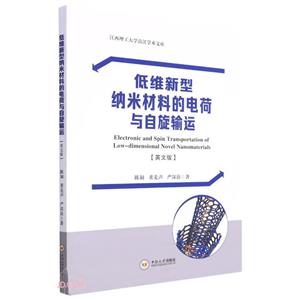掃一掃
關注中圖網
官方微博
本類五星書更多>
-
>
公路車寶典(ZINN的公路車維修與保養秘籍)
-
>
晶體管電路設計(下)
-
>
基于個性化設計策略的智能交通系統關鍵技術
-
>
花樣百出:貴州少數民族圖案填色
-
>
山東教育出版社有限公司技術轉移與技術創新歷史叢書中國高等技術教育的蘇化(1949—1961)以北京地區為中心
-
>
鐵路機車概要.交流傳動內燃.電力機車
-
>
利維坦的道德困境:早期現代政治哲學的問題與脈絡
低維新型納米材料的電荷與自旋輸運 (英文版) 版權信息
- ISBN:9787548749783
- 條形碼:9787548749783 ; 978-7-5487-4978-3
- 裝幀:一般膠版紙
- 冊數:暫無
- 重量:暫無
- 所屬分類:>
低維新型納米材料的電荷與自旋輸運 (英文版) 內容簡介
本書主要對低維納米結模型器件中的電荷和自旋輸運進行了理論研究。在簡要回顧納米器件中量子傳輸的基本理論方法后,深入探討了分子器件中的開關比、自旋過濾以及自旋極化等,并給出相應的輸運量子調控的理論機理。
低維新型納米材料的電荷與自旋輸運 (英文版) 目錄
Chapter 1 Introduction
Chapter 2 Basic theories for quantum transport
2.1 Born-Oppenheimer approximation
2.2 Molecular dynamic simulation
2.2.1 Classical molecular dynamics
2.2.2 Ab initio molecular dynamics
2.2.3 Particle statistics
2.3 Electronic structure methods
2.3.1 Hartree-fock method
2.3.2 Density functional theory
2.4 General transport theory
2.4.1 Drude model
2.4.2 Boltzmann transport equation
2.4.3 Linear response transport theory
2.4.4 Quantum transport theory
2.4.5 Landauer approach
2.4.6 Lippmann-Schwinger equation
2.4.7 Non-equilibrium Green's function approach
Chapter 3 Electronic structures and transport properties of low-dimensional GaN nanoderivatives: a first-principles study
3.1 Introduction
3.2 Sample structure and computational details
3.3 Results and discussions
3.3.1 Electronic structures of two-dimensional bilayer GaN structures
3.3.2 Transport characteristics of one-dimensional GaN devices
3.4 Conclusion
Chapter 4 Length-independent multifunctional device based on penta-tetra-pentagonal molecule: a first-principles study
4.1 Introduction
4.2 Model and method
4.3 Result and discussion
4.4 Summary and conclusion
Chapter 5 Modulating the properties of multi-functional molecular devices consisting of zigzag gallium nitride nanoribbons by different magnetic orderings: a first-principles study
5.1 Introduction
5.2 Models and methods
5.3 Results and discussion
5.4 Conclusions
Chapter 6 Modulation of electrical performance of zigzag edged tetra-penta-octagonal graphene nanoribbons based devices via
boundary passivations
6. 1 Introduction
6.2 Sample structure and computational details
6. 3 Results and discussion
6. 3.1 Electronic structures of TPO-zGNRs-H
6. 3.2 Electronic properties of TPO-zGNRs-X
6. 3.3 Transport properties of TPO-zGNRs-X model devices
6. 3.4 An obvious rectification and NDR effects in TPO-zGNRs-H/O model device
6.4 Conclusions
Chapter 7 Direction and strain controlled anisotropic transport behaviors of 2D GeSe-phosphorene vdW heterojunctions
7.1 Introduction
7.2 Sample structure and computational details
7.3 Results and discussion
7.4 Conclusions
Chapter 8 Carbon phosphide nanosheet and nanoribbon: insights on modulating their electronic properties by first principles
calculations
8.1 Introduction
8.2 Model and methods
8.3 Results and discussion
8.4 Conclusions
Chapter 9 High-performance spin rectification in gallium nitride- based molecular junctions with asymmetric edge passivation
9.1 Introduction
9.2 Models and methods
9.3 Results and discussion
9.3.1 Edge-passivation spin transmission
9.3.2 Width-independent rectification behavior
9.4 Conclusions
9.5 Supplementary material
Chapter 10 Modulation of electronic structure properties of C/B/AI-doped armchair GaN nanoribbons
10.1 Introduction
10.2 Model and method
10.3 Results and discussion
10.4 Conclusion
Chapter 11 Investigation of the electronic and magnetic properties of low-dimensional FeCl2 derivatives by first-principles
calculations
11.1 Introduction
11.2 Computational details
11.3 Results and discussion
11.4 Conclusions
Chapter 12 Modulation of electronic behaviors of InSe nanosheet and nanoribbons: the first-principles study
12.1 Introduction
12.2 Computational details
12.3 Results and discussion
12.3.1 Electronic structures of InSe nanosheet
12.3.2 Electronic structures of InSe nanoribbon
12.3.3 Electronic transport properties of zISNs
12.4 Conclusions
12.5 Supplementary material
References
Acknowledgement
Chapter 2 Basic theories for quantum transport
2.1 Born-Oppenheimer approximation
2.2 Molecular dynamic simulation
2.2.1 Classical molecular dynamics
2.2.2 Ab initio molecular dynamics
2.2.3 Particle statistics
2.3 Electronic structure methods
2.3.1 Hartree-fock method
2.3.2 Density functional theory
2.4 General transport theory
2.4.1 Drude model
2.4.2 Boltzmann transport equation
2.4.3 Linear response transport theory
2.4.4 Quantum transport theory
2.4.5 Landauer approach
2.4.6 Lippmann-Schwinger equation
2.4.7 Non-equilibrium Green's function approach
Chapter 3 Electronic structures and transport properties of low-dimensional GaN nanoderivatives: a first-principles study
3.1 Introduction
3.2 Sample structure and computational details
3.3 Results and discussions
3.3.1 Electronic structures of two-dimensional bilayer GaN structures
3.3.2 Transport characteristics of one-dimensional GaN devices
3.4 Conclusion
Chapter 4 Length-independent multifunctional device based on penta-tetra-pentagonal molecule: a first-principles study
4.1 Introduction
4.2 Model and method
4.3 Result and discussion
4.4 Summary and conclusion
Chapter 5 Modulating the properties of multi-functional molecular devices consisting of zigzag gallium nitride nanoribbons by different magnetic orderings: a first-principles study
5.1 Introduction
5.2 Models and methods
5.3 Results and discussion
5.4 Conclusions
Chapter 6 Modulation of electrical performance of zigzag edged tetra-penta-octagonal graphene nanoribbons based devices via
boundary passivations
6. 1 Introduction
6.2 Sample structure and computational details
6. 3 Results and discussion
6. 3.1 Electronic structures of TPO-zGNRs-H
6. 3.2 Electronic properties of TPO-zGNRs-X
6. 3.3 Transport properties of TPO-zGNRs-X model devices
6. 3.4 An obvious rectification and NDR effects in TPO-zGNRs-H/O model device
6.4 Conclusions
Chapter 7 Direction and strain controlled anisotropic transport behaviors of 2D GeSe-phosphorene vdW heterojunctions
7.1 Introduction
7.2 Sample structure and computational details
7.3 Results and discussion
7.4 Conclusions
Chapter 8 Carbon phosphide nanosheet and nanoribbon: insights on modulating their electronic properties by first principles
calculations
8.1 Introduction
8.2 Model and methods
8.3 Results and discussion
8.4 Conclusions
Chapter 9 High-performance spin rectification in gallium nitride- based molecular junctions with asymmetric edge passivation
9.1 Introduction
9.2 Models and methods
9.3 Results and discussion
9.3.1 Edge-passivation spin transmission
9.3.2 Width-independent rectification behavior
9.4 Conclusions
9.5 Supplementary material
Chapter 10 Modulation of electronic structure properties of C/B/AI-doped armchair GaN nanoribbons
10.1 Introduction
10.2 Model and method
10.3 Results and discussion
10.4 Conclusion
Chapter 11 Investigation of the electronic and magnetic properties of low-dimensional FeCl2 derivatives by first-principles
calculations
11.1 Introduction
11.2 Computational details
11.3 Results and discussion
11.4 Conclusions
Chapter 12 Modulation of electronic behaviors of InSe nanosheet and nanoribbons: the first-principles study
12.1 Introduction
12.2 Computational details
12.3 Results and discussion
12.3.1 Electronic structures of InSe nanosheet
12.3.2 Electronic structures of InSe nanoribbon
12.3.3 Electronic transport properties of zISNs
12.4 Conclusions
12.5 Supplementary material
References
Acknowledgement
展開全部
書友推薦
- >
唐代進士錄
- >
經典常談
- >
我與地壇
- >
伯納黛特,你要去哪(2021新版)
- >
小考拉的故事-套裝共3冊
- >
煙與鏡
- >
羅曼·羅蘭讀書隨筆-精裝
- >
朝聞道
本類暢銷
















